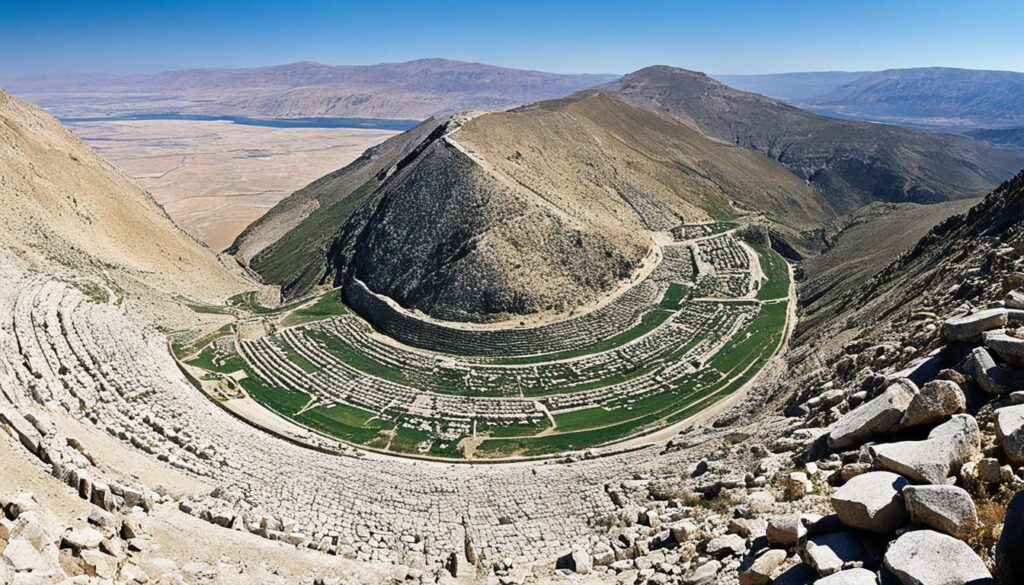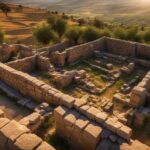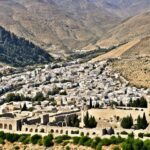Mount Ebal holds great biblical significance as one of the twin peaks located in the Promised Land of Israel. Alongside Mount Gerizim, it played a crucial role in the reading of blessings and curses upon the Israelites for their obedience or disobedience to God’s laws. This sacred mountain, known today as Sitti Salamiyah, served as a solemn reminder of the consequences that follow when we choose to stray from God’s path.
Key Takeaways:
- Mount Ebal is a prominent biblical site located in the Middle of Samaria.
- It was designated by God for the proclamation of blessings and curses.
- Mount Ebal stands as a warning of the serious consequences of sin.
- It reminds us of the importance of obeying God’s commandments.
- Today, Mount Ebal attracts visitors interested in exploring biblical history and geography.
Historical Significance of Mount Ebal
Mount Ebal holds significant historical importance as a prominent site throughout the biblical narrative. Referred to in both Deuteronomy and Joshua, it was the location where blessings and curses were pronounced over the Israelites, signifying the renewal of the Mosaic Covenant. This event served as a solemn warning to the people, emphasizing the consequences of their obedience or disobedience to God’s laws.
Both Mount Ebal and its twin peak, Mount Gerizim, played crucial roles in Israelite history, serving as prominent landmarks and places of religious significance. These mountains stood as reminders of God’s presence and the covenant relationship between Him and His chosen people.
“And afterward he read all the words of the law, the blessings and the cursings, according to all that is written in the book of the law. There was not a word of all that Moses had commanded which Joshua did not read before all the assembly of Israel, with the women, the little ones, and the strangers who were living among them.”
Mount Ebal functioned as a powerful symbol, reminding the Israelites of the consequences they would face if they strayed from God’s commands. It stood as a testament to God’s justice and the severity of His judgments against sin.
The Role of Mount Ebal and Mount Gerizim in the Israelite Conquest
During the Israelite conquest of the Promised Land, Mount Ebal and Mount Gerizim played pivotal roles in establishing the Israelites’ identity as God’s chosen people. After the victories at Jericho and Ai, Joshua gathered the people on Mount Ebal to read the law and reaffirm their commitment to the covenant with God. The blessings and curses pronounced on this sacred mountain served as a solemn reminder of the consequences of their actions and potential disobedience. This important event solidified the Israelites’ adherence to God’s laws and their reliance on His guidance throughout their journey.
Ancient Landmarks and Biblical Sites
Mount Ebal, alongside Mount Gerizim, are ancient landmarks that hold immense biblical and historical significance. Today, visitors and pilgrims can explore these sacred sites, immersing themselves in the rich tapestry of biblical history and geography. Witnessing the breathtaking views from both mountains allows individuals to connect with the events and stories that unfolded in this land thousands of years ago.
| Mount Ebal | Mount Gerizim |
|---|---|
| Location | Location |
| Mount Ebal is located in the Promised Land of Israel, near the middle of Samaria. Today, it is known as Sitti Salamiyah. | Mount Gerizim is situated in the West Bank, near the city of Nablus. It serves as the southern side of the valley in which Nablus is located. |
| Religious Significance | Religious Significance |
| Mount Ebal is prominently featured in the Bible as the place where the blessings and curses were pronounced on the Israelites. It signifies the renewal of the covenant and serves as a stark reminder of the consequences of obedience and disobedience. | Mount Gerizim is associated with blessings and is often regarded as a symbol of God’s favor. In the Bible, it stands in contrast to Mount Ebal, representing the consequences of disobedience and the importance of following God’s laws. |
Geographical Location of Mount Ebal
Mount Ebal is located in the West Bank of the Jordan River, near the city of Nablus. It forms the northern side of the scenic valley in which Nablus is situated, with Mount Gerizim forming the southern side. This region holds great historical and biblical significance, known as Shechem in ancient times. Biblical figures such as Abraham, Jacob, and Joseph have notable connections to this area, adding to its cultural and religious importance.
For those interested in exploring the biblical sites and immersing themselves in the rich history of the Holy Land, Mount Ebal is an essential destination. Its geographical location enhances its appeal as it is easily accessible for tourists, particularly those on Holy Land tours. Visitors can experience the stunning landscapes, walk in the footsteps of biblical figures, and gain a deeper understanding of the significance of Mount Ebal in the Bible.

Whether it’s standing atop Mount Ebal, gazing at the panoramic views, or visiting nearby archaeological sites, the geographical location of Mount Ebal offers an immersive experience that brings the biblical narratives to life. Discover the spiritual and cultural richness of this remarkable region as you embark on a journey through the heart of the Holy Land.
Explore the Biblical Sites
Mount Ebal is just one of the many compelling destinations in the Holy Land that captivate the imagination and deepen one’s understanding of the biblical stories. Plan your Holy Land tour to include Mount Ebal and other significant sites such as Mount Gerizim, Jerusalem, Bethlehem, and the Sea of Galilee. Each place offers a unique glimpse into the rich tapestry of history, faith, and culture that defines this sacred region.
| Key Features | Highlights |
|---|---|
| Historical Significance | Experience the geographical location steeped in biblical narratives |
| Archaeological sites | Explore the ancient ruins and unearthed artifacts |
| Scenic beauty | Marvel at the breathtaking landscapes |
| Cultural immersion | Interact with the local communities and traditions |
| Spiritual exploration | Reflect and connect with your faith in a meaningful way |
“Mount Ebal, with its picturesque surroundings and historical importance, offers a unique opportunity to delve into the ancient world and discover the wonders of the Holy Land.” – Traveler’s Review.
Embark on a transformative journey to Mount Ebal and experience the geographical location filled with biblical significance. Immerse yourself in the captivating history, breathtaking landscapes, and spiritual depth of the Holy Land.
Archaeological Discoveries on Mount Ebal
Mount Ebal has been the subject of archaeological excavations, shedding light on its historical significance and providing insights into early Israelite cultic activity. In 1980, Israeli archaeologist Adam Zertal discovered a significant structure during the Manasseh Hill Country Survey on Mount Ebal.
Excavations conducted by the University of Haifa and the Israel Exploration Society have yielded fascinating artifacts, including scarabs, seals, and animal bones, dating back to the Iron Age I period. These discoveries provide valuable evidence of human occupation and religious practices in the region during ancient times.
The structure found on Mount Ebal is believed by most archaeologists to be an early Israelite cultic site, possibly the altar described in the Book of Joshua. This identification, however, remains a topic of debate among scholars, and further research and excavations are necessary to fully comprehend the archaeological significance of Mount Ebal.
Archaeological Discoveries on Mount Ebal
| Discovery | Significance |
|---|---|
| Structural remains | Indicate the presence of an early Israelite cultic site |
| Scarabs and seals | Suggest religious and administrative activities |
| Animal bones | Provide insight into sacrificial practices |
The ongoing exploration of Mount Ebal serves as a testament to the importance of archaeological excavation in unravelling the mysteries of the past. Each discovery offers valuable clues that contribute to our understanding of early Israelite culture and religious customs.
Theological Themes Associated with Mount Ebal
Mount Ebal holds profound theological significance in the Bible, encompassing several key themes and symbolizing the renewal of the Mosaic Covenant between God and the Israelites.
The reading of blessings and curses on Mount Ebal served as a visual representation of God’s justice and His expectations for His chosen people. The event highlighted the consequences of obedience and disobedience to God’s laws, underscoring the importance of living according to His commandments.
The Mosaic Covenant, established between God and Israel through Moses, outlined the terms of their relationship and the responsibilities of both parties. Mount Ebal became a significant location for the Israelites, as it stood as a reminder of the divine covenant and the moral and ethical standards they were called to uphold.
By presenting the blessings and curses on Mount Ebal, God reiterated His expectations, emphasizing the connection between obedience to His laws and the resulting outcomes. This theological theme reflects the divine justice inherent in God’s character and His desire for His people to walk in righteousness.
“And Moses and the priests, the Levites, spoke to all Israel, saying, ‘Be attentive and listen, O Israel: This day you have become the people of the Lord your God. You shall therefore obey the voice of the Lord your God, keeping his commandments and his statutes, which I command you today.'”
The reading of blessings and curses on Mount Ebal, as described in the biblical narrative, serves as a pivotal moment in the relationship between God and His people. It reinforces the theological significance of Mount Ebal and the enduring lessons it teaches about obedience, consequences, and the importance of living in accordance with God’s will.
Key Biblical Events on Mount Ebal
Mount Ebal played a pivotal role in several key biblical events that shaped Israelite history. After the victorious battles of Jericho and Ai, Joshua gathered the Israelites on Mount Ebal to read the law and renew their covenant with God. This sacred gathering marked an important moment of commitment and obedience to God’s commandments.
On Mount Ebal, the curses for disobedience were pronounced as a stark warning to the Israelites, emphasizing the consequences of turning away from God’s laws. This served as a powerful reminder that God takes sin seriously and expects His people to live according to His righteous standards.
Furthermore, the events on Mount Ebal were instrumental in the Israelite conquest of the Promised Land. It solidified their identity as God’s chosen people and highlighted the significance of obedience in fulfilling His divine plan.

“Assemble the people — men, women, and children, as well as the foreigners living in your towns — so they can listen and learn to fear the LORD your God and carefully obey all the words of this law. Then their children, who do not know this law, will also hear and learn to fear the LORD your God as long as you live in the land you are crossing the Jordan to possess.”
Significance of the Events
The gatherings and pronouncement of blessings and curses on Mount Ebal were significant in reinforcing the Israelites’ commitment to God’s covenant. It underscored the importance of adhering to His laws and reminded them of the consequences of straying from His path.
These events on Mount Ebal also serve as a timeless reminder for believers today. They highlight the importance of wholehearted devotion to God, obedience to His commandments, and the need to understand the gravity of sin and its consequences in our lives.
Biblical References
| Event | Biblical Reference |
|---|---|
| Reading of the law on Mount Ebal | Joshua 8:30-35 |
| Pronouncement of blessings and curses | Deuteronomy 27:11-26 |
Cultural and Religious Practices on Mount Ebal
Mount Ebal held significant cultural and religious practices for the Israelites. The formal reading of the law and the active participation of the entire assembly, including women, children, and foreigners, underscored the communal nature of their faith.
“And all Israel, and their elders and their officers, and their judges, stood on this side the ark and on that side before the priests the Levites, which bare the ark of the covenant of the LORD, as well the stranger, as he that was born among them; half of them over against mount Gerizim, and half of them over against mount Ebal; as Moses the servant of the LORD had commanded before, that they should bless the people of Israel.” – Joshua 8:33
The curses pronounced on Mount Ebal served as a strong deterrent against various sinful practices, including idolatry and dishonoring parents. Mount Ebal represented the moral and ethical standards that the Israelites were called to follow, reminding them of the consequences of deviating from God’s commands.
| Cultural Practices | Religious Practices | Significance of Mount Ebal |
|---|---|---|
|
|
|

Prophetic and Eschatological Significance of Mount Ebal
Mount Ebal in the Bible carries profound prophetic and eschatological significance. Many scholars believe that the blessings and curses pronounced on Mount Ebal foreshadow the final judgment and redemption of humanity. These warnings against disobedience and the call to obedience serve as a reminder of God’s ultimate plan for restoration.
“And now, Israel, what does the Lord your God require of you, but to fear the Lord your God, to walk in all his ways, to love him, to serve the Lord your God with all your heart and with all your soul, and to keep the commandments and statutes of the Lord, which I am commanding you today for your good?” (Deuteronomy 10:12-13)
Mount Ebal symbolizes God’s faithfulness and His desire for His people to walk in righteousness. It stands as a reminder that God’s laws are not arbitrary but carry a prophetic significance, revealing His ultimate plan for humanity’s redemption and restoration.
| Prophetic Significance | Eschatological Significance |
|---|---|
| Foreshadows final judgment | Symbolizes restoration |
| Emphasizes the consequences of obedience and disobedience | Represents God’s faithfulness |
| Highlights the importance of walking in righteousness | Reveals God’s ultimate plan for redemption |
Mount Ebal’s prophetic and eschatological significance serves as a powerful reminder of God’s unwavering love and His desire for humanity to live in alignment with His divine instructions.

Significance of Mount Ebal in Modern Times
Mount Ebal, with its rich biblical history and cultural importance, continues to hold significant meaning in modern times. It serves as an intriguing destination for those seeking to explore the depths of biblical history and embark on religious pilgrimages. Visitors are drawn to Mount Ebal due to its association with both significant archaeological discoveries and key biblical events, offering a deeper understanding of the biblical narrative.
The geographical location of Mount Ebal in the West Bank makes it easily accessible to tourists, particularly those on Holy Land tours. Its proximity to the city of Nablus and its historical connection to biblical figures like Abraham, Jacob, and Joseph add to its allure.
“Mount Ebal stands as a testament to the enduring significance of biblical sites and the invaluable insights they provide into our shared religious heritage.”
The archaeological finds on Mount Ebal shed light on early Israelite cultic activities. The remnants uncovered during excavations, including scarabs, seals, and animal bones dating back to the Iron Age I period, have contributed to our understanding of the historical and religious practices of ancient Israelites.
Moreover, Mount Ebal’s role in pivotal biblical events adds to its intrigue. It was on this mountain that Joshua gathered the people to read the law and renew the covenant, emphasizing the importance of obedience to God’s commandments and the consequences of disobedience. The warnings and curses pronounced on Mount Ebal served as a powerful reminder of God’s justice and the need for faithful adherence to His laws.
The modern significance of Mount Ebal lies in its ability to connect visitors to their religious roots, offering a tangible experience that resonates with the biblical narrative. The exploration of this sacred site allows individuals to engage with their faith, seek spiritual insight, and gain a deeper appreciation for the timeless teachings found within the Bible.

Whether visitors are seeking to uncover archaeological treasures, immerse themselves in biblical history, or embark on a spiritual journey, Mount Ebal continues to captivate and inspire. This mountaintop destination serves as a beacon, calling upon individuals to reflect on the significance of obedience to God’s laws and the enduring relevance of biblical teachings in our modern world.
Prominent Features of Mount Ebal
Mount Ebal, located in the West Bank of the Jordan River, stands as a notable geographical landmark with distinct features that contribute to its significance. This section explores the prominent attributes that make Mount Ebal a unique and visually captivating site.
Rocky Terrain and Limestone Composition
Mount Ebal is characterized by its rugged surface formations, predominantly composed of limestone. The rocky terrain of the mountain creates a dramatic visual impact, showcasing the raw beauty of nature. The limestone composition adds to the mountain’s appeal, with its pale, striking appearance against the blue sky.
Caverns and Caves
Beneath the surface of Mount Ebal lie numerous caverns and caves, adding an air of mystery and adventure to the mountain. These natural formations have always been sources of intrigue and fascination, invoking a sense of exploration and discovery.
Elevated Height
Ascending to an impressive 3,080 feet above sea level, Mount Ebal ranks among the highest peaks in the West Bank. Its considerable height offers sweeping panoramic views of the surrounding landscape, further enhancing the awe-inspiring experience of being on the mountain.
Visual Contrast with Mount Gerizim
One of the striking features of Mount Ebal is the stark visual contrast it presents alongside its twin peak, Mount Gerizim. While Mount Ebal is rocky and barren, Mount Gerizim boasts lush and fertile vegetation. This stark contrast highlights the symbolism associated with Mount Ebal, representing blessings and curses as depicted in biblical narratives.
Mount Ebal’s prominent features, including its rugged surface formations, limestone composition, caverns and caves, elevated height, and visual contrast with Mount Gerizim, contribute to its unique identity and significance.
The Renewal of the Covenant on Mount Ebal
The renewal of the covenant on Mount Ebal holds immense significance in the biblical narrative. It represents a profound moment in the Israelites’ journey, symbolizing their commitment to God and His law. The reading of blessings and curses on Mount Ebal served as a powerful reminder of the consequences that accompany obedience and disobedience. It reinforced the covenant relationship between the Israelites and God, urging them to live according to His commandments.
The renewal of the covenant on Mount Ebal serves as a pivotal point in the biblical storyline, showcasing the importance of obedience and adherence to God’s laws. This event demonstrated the seriousness with which God views sin and the far-reaching consequences that follow its transgression.
By standing on Mount Ebal, the Israelites were confronted with the gravity of their covenant with God. They were reminded of their responsibility to honor the covenant and the dire consequences of neglecting it.
“Cursed be anyone who does not confirm the words of this law by doing them.” – Deuteronomy 27:26
The renewal of the covenant on Mount Ebal highlights the indispensable nature of divine obedience in the Israelites’ relationship with God. It emphasizes the need to consistently align their actions with His commandments, understanding that their obedience establishes a firm foundation for their walk of faith.
This image depicts the awe-inspiring landscape of Mount Ebal, where the renewal of the covenant took place. The majestic mountainside serves as a visual reminder of the profound significance of this event in biblical history.
The renewal of the covenant on Mount Ebal evokes contemplation and reflection on our own relationship with God. It prompts us to examine the level of obedience in our lives and the consequences we face when we deviate from His commands.
The significance of Mount Ebal resonates throughout the biblical narrative, reminding us of the timeless truths contained within God’s word. It stands as a powerful testament to the enduring nature of the covenant between God and His people, inviting us to live in obedience and experience the blessings that flow from walking in His ways.
Conclusion
Mount Ebal in the Bible holds immense biblical significance, serving as the site where the Mosaic Covenant was renewed and blessings and curses were pronounced. Its historical, geographical, and archaeological aspects contribute to its importance, making it a destination of interest for those seeking to explore the biblical sites and understand the geography of the Holy Land. Mount Ebal serves as a powerful reminder of the Israelites’ journey and their relationship with God, underscoring the importance of obedience to His laws and the consequences that follow.
With its rugged surface formations and limestone composition, Mount Ebal stands as a visual contrast to its twin peak, Mount Gerizim. The barrenness of Mount Ebal embodies the curses that result from disobedience, while the lushness of Mount Gerizim represents the blessings that come with obedience. This symbolism further enhances the significance of Mount Ebal in the biblical narrative.
Today, Mount Ebal continues to captivate visitors who seek to immerse themselves in the biblical history and heritage. Its archaeological discoveries, along with the key events and theological themes associated with the mountain, offer profound insights into the Israelites’ journey and their covenant relationship with God. Mount Ebal stands as a testament to the enduring relevance and timeless lessons found within the pages of the Bible.







